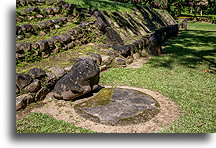Approximately 100 km / 62 miles from the archaeological site of Monte Alto in Guatemala lies Tak'alik Ab'aj. The latter had a lot of studies and archeologists agree that this site had continuous settlement history from before 800 BC to after AD 1200. The changing architectural styles and iconography of Takaliku Abaj suggest that it was a place inhabited by various ethnic groups. In the Middle Preclassic period (800–300 BC), the population may have been associated with the Olmec culture of the Gulf Coast lowlands region. In the Late Preclassic period (300 BC – AD 250), Maya styles begin to dominate with fading Olmec elements. This was probably a shift accompanied by an influx of ethnic Maya population.



Takalik Abaj is unique because Maya hieroglyphic inscriptions here are among the earliest in the entire Mayan region. Characteristic of the Pacific lowlands, the potbelly style of sculpture—very similar to those at Monte Alto—began to appear here around AD 300. The potbellies are not known in Maya art outside this region.



It is the site of the most sculptured monuments found in the entire Pacific lowlands and one of the largest concentrations of Olmec-style carvings outside the Gulf of Mexico. It is interesting that some of the colossal heads have been reworked to achieve a different artistic expression. There are also finds indicating contact with Teotihuacan, a metropolis 1000 km / 600 mi away, which at one point conquered Takalik Abaj.


At Tak'alik Ab'aj, archaeologists have discovered not only platforms and sculptures. This town had stone canals used as a drainage system for major structures. Many tombs have been discovered here, one of which is the oldest royal burial place in the entire Maya world. There is also evidence of monuments arranged in rows that served as an astronomical observatory. Two thousand years ago, the inhabitants of this city watched the celestial sphere to create their concept of the relationship between humans, the earth and the universe.


The city flourished in the Preclassic and Classic periods, from the 9th century BC through to at least the 10th century AD, and was an important center of commerce. After AD 1200 original inhabitants slowly abandoned the city, that they had occupied for almost two millennia.




